
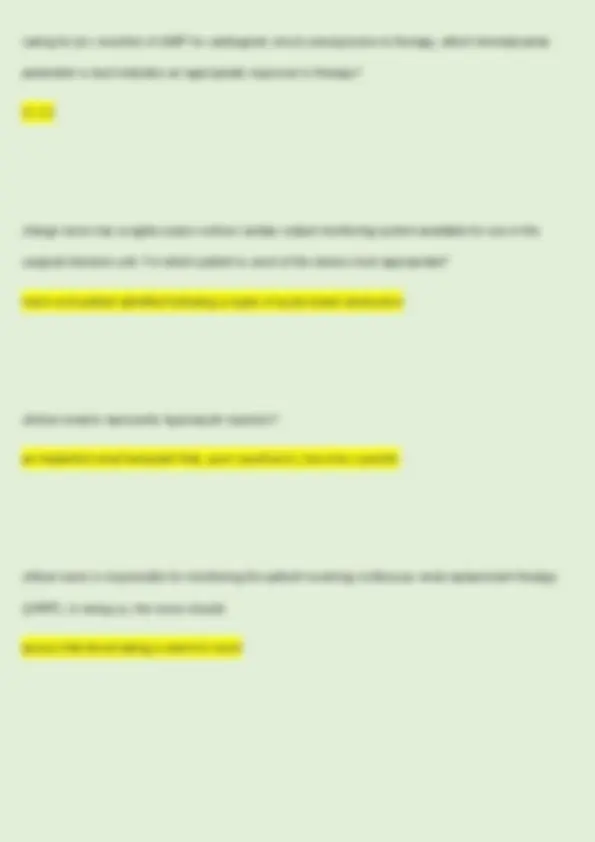
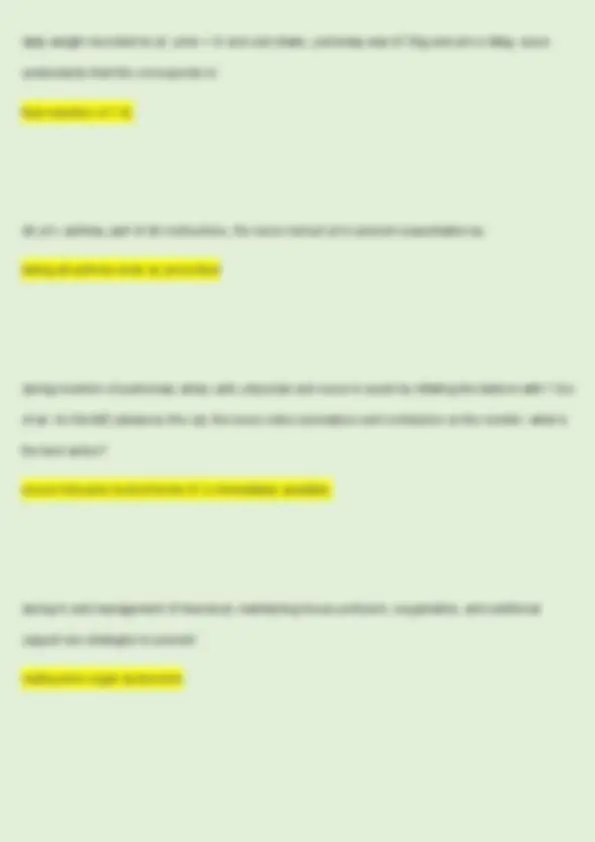
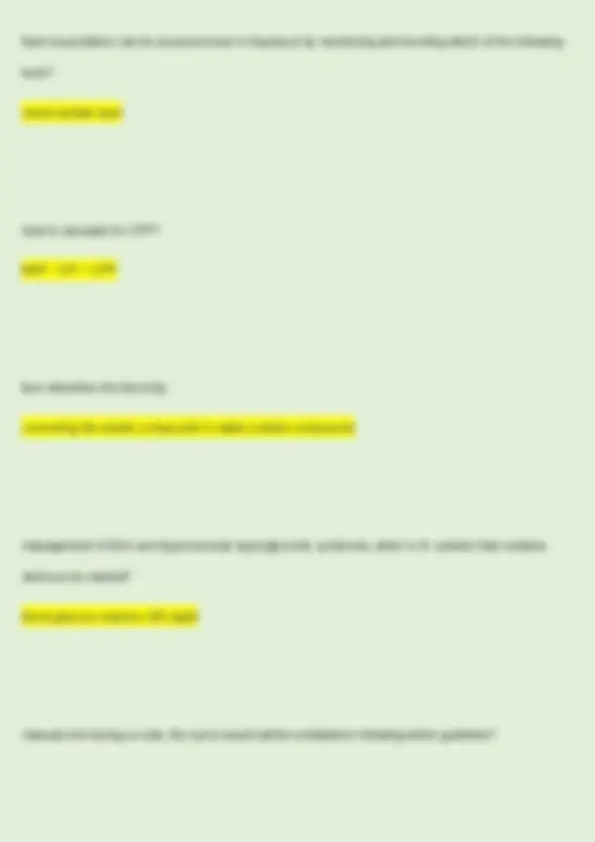

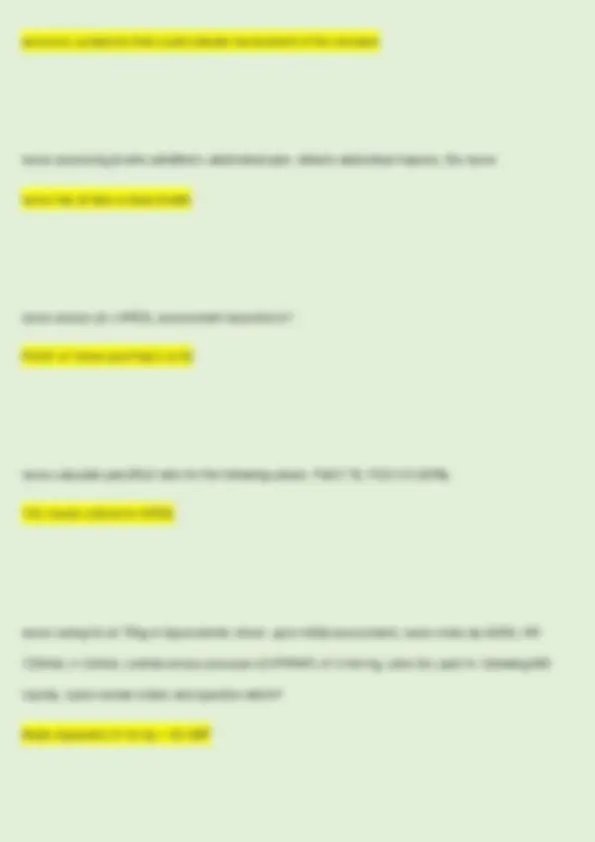
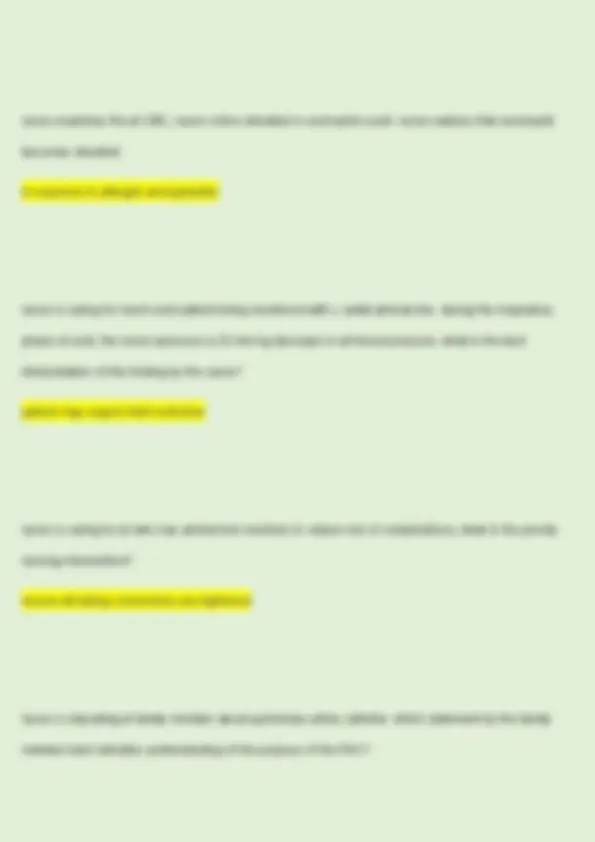
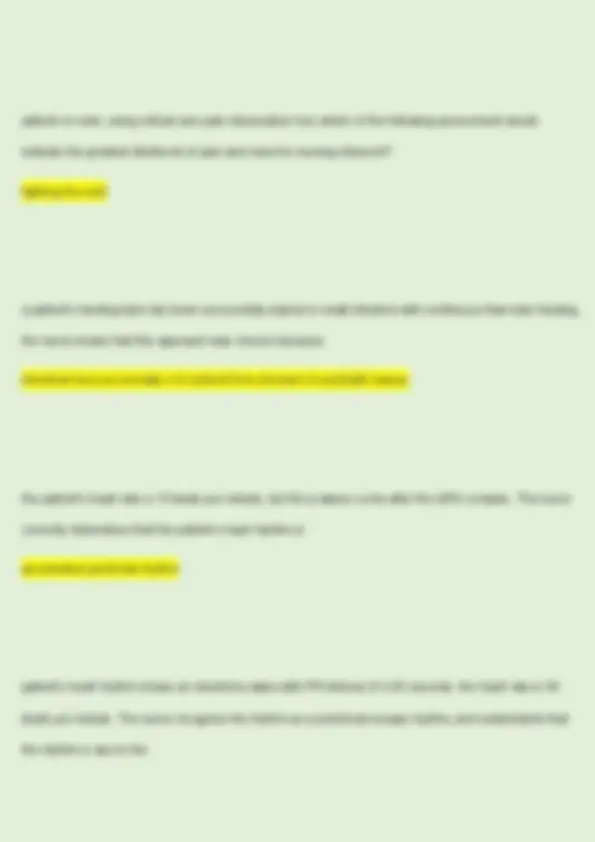
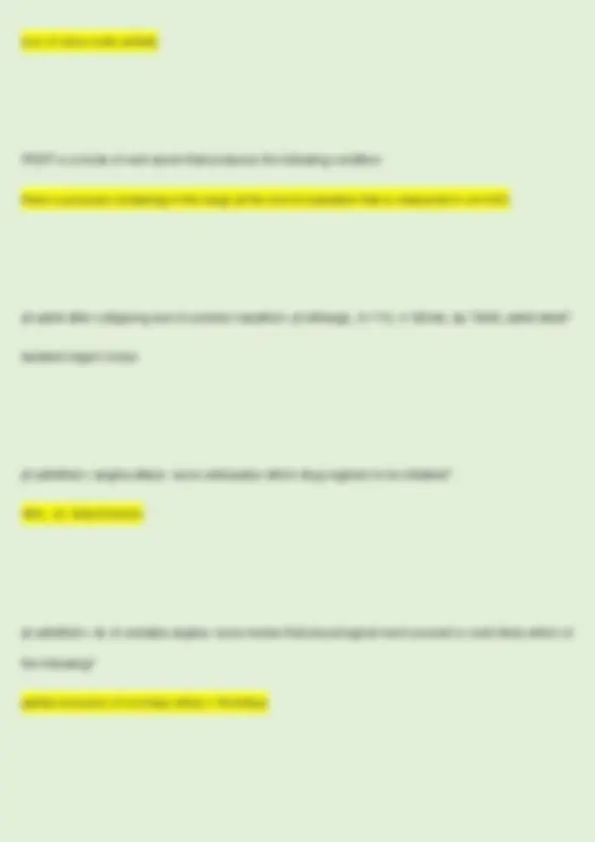
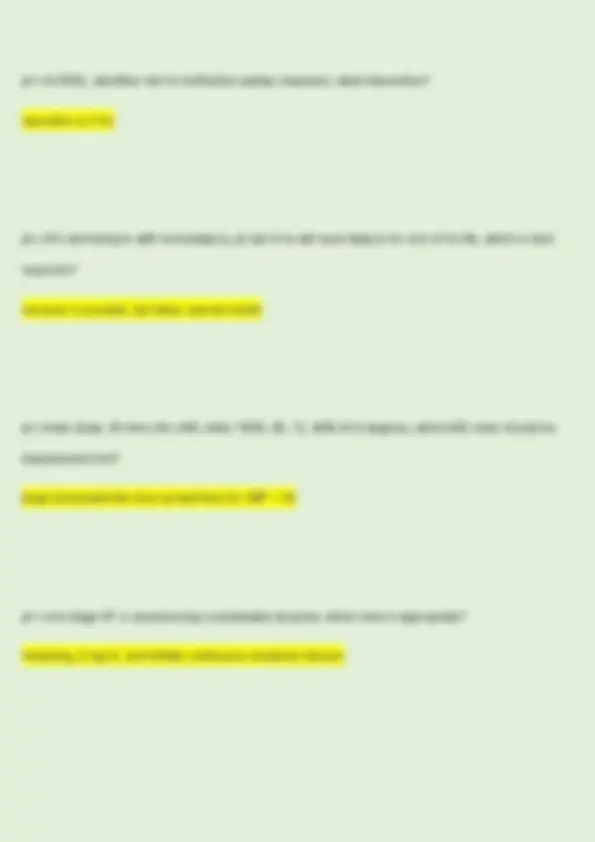
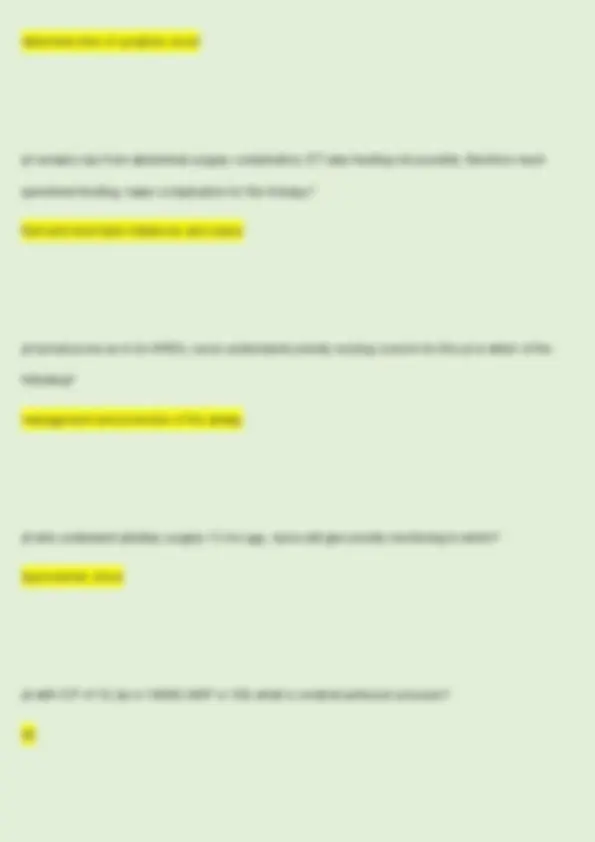
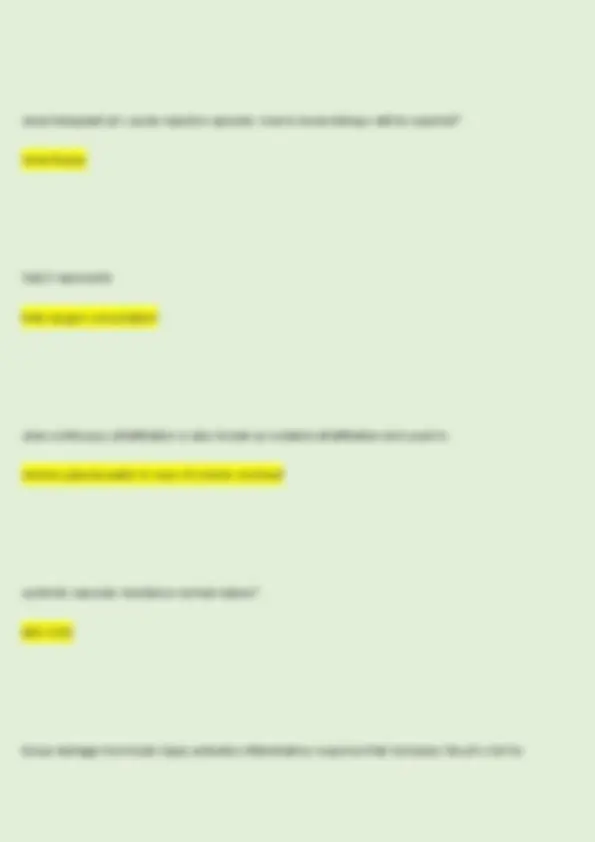

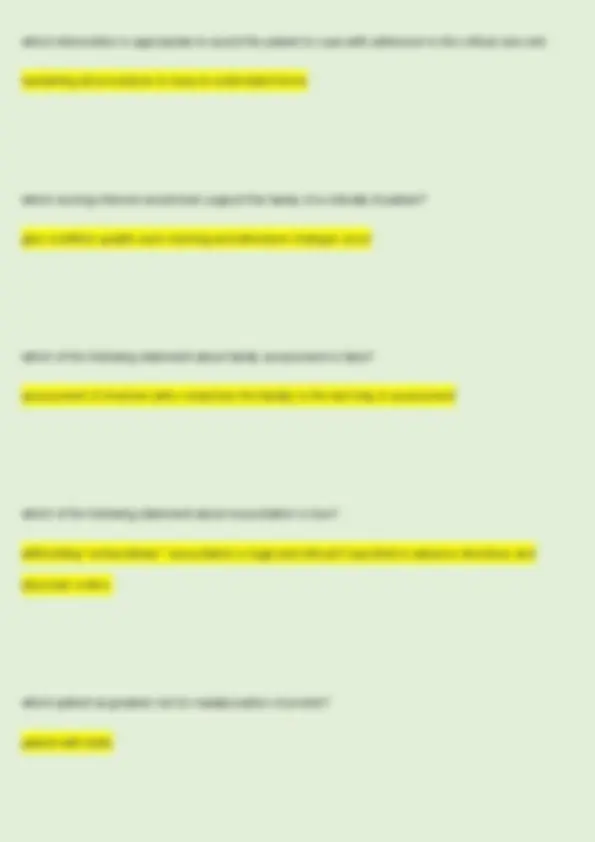
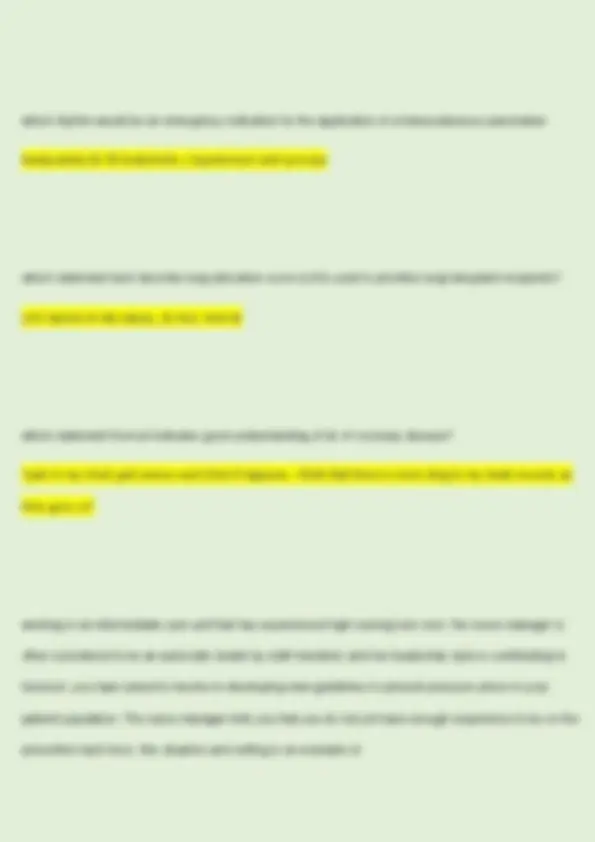



Study with the several resources on Docsity

Earn points by helping other students or get them with a premium plan


Prepare for your exams
Study with the several resources on Docsity

Earn points to download
Earn points by helping other students or get them with a premium plan
Community
Ask the community for help and clear up your study doubts
Discover the best universities in your country according to Docsity users
Free resources
Download our free guides on studying techniques, anxiety management strategies, and thesis advice from Docsity tutors
A series of short answer questions and answers related to critical care nursing, specifically focusing on the nclex-rn exam. It covers a range of topics including end-of-life care, ventilator management, asthma exacerbations, hemodynamic monitoring, and various disease states such as ards, dka, and heart failure. The questions are designed to test the nurse's knowledge and application of evidence-based practices in the critical care setting. Useful for nursing students preparing for the nclex-rn exam or for practicing nurses seeking to review key concepts in critical care. It offers concise answers and practical scenarios to enhance understanding and clinical decision-making skills. The content is relevant for both academic study and professional development in the field of nursing.
Typology: Exams
1 / 23

This page cannot be seen from the preview
Don't miss anything!
















65 YO pt c history of metastatic lung carcinoma has been unresponsive to chemo. the medical team has determined that there are no additional tx available that will prolong life or improve the quality of life in any meaningful way. Despite the poor prognosis, the pt continues to rc'd chemo and full nutrition support. what is this example of end of life concept?
medical futility
as part of nursing management of critically ill patient, orders are written to keep the head of the bed elevated at 30 degrees, awaken the patient from sedation each morning to assess readiness to wean from mech vent, and implement oral care protocol every 4 hours. These intervention are done as a group to reduce the risk of vent-associated pneumonia. This group of evidence-based interventions is often called:
bundle of care
asthma exacerbation, what tx?
inhaled bronchodilators and IV corticosteroids?
best way to administer benzo intermittently is?
titrate to a predefined endpoint using a standard sedation scale
blood work includes h/h, nurse understands that
hematocrit values does not change substantially during the first few hours
cardiologist told pt and family that dx is hypertrophic cardiomyopathy; what cause this condition is?
"inherited condition. you should give serious consideration to having family members screened for it"
care for neutropenic pt is same for all immunocompromised pt. desires pt outcome related to medical and nursing interventions include absence of infection, negative culture, and an absolute neutrophil count of?
1500 cell/mcl or higher
daily weight recorded for pt. urine < IV and oral intake. yesterday was 97.5kg and am is 99kg. nurse understands that this corresponds to:
fluid retention of 1.5L
d/c pt c asthma, part of d/c instructions, the nurse instruct pt to prevent exacerbation by
taking all asthma meds as prescribed
during insertion of pulmonary artery cath, physician ask nurse to assist by inflating the balloon with 1.5cc of air. As the MD advances the cat, the nurse notice premature vent contraction on the monitor. what is the best action?
ensure lidocaine hydrochloride IV is immediately available.
during tx and management of trauma pt, maintaining tissue perfusion, oxygenation, and nutritional support are strategies to prevent:
multisystem organ dysfunction
fluid resuscitation can be assessed best in trauma pt by monitoring and trending which of the following tests?
serum lactate level
how to calculate for CPP?
MAP - ICP = CPP
liver detoxifies the blood by:
converting fat-soluble compounds to water-soluble compounds
management of DKA and hyperosmolar hyperglycemic syndrome, when is IV solution that contains dextrose be started?
blood glucose reaches 250 mg/dl
manual vent during a code, the nurse would admin ventilations following which guideline?
reduce patient error
neuromuscular blocking agents are used in the management of some vent patient; their primary mdoe of action is
paralysis
neuromuscular blocking agents are used in the management of some vent patient. their primary mode of action is
paralysis
normal artery occlusion pressure?
6 - 12
normal cardiac index?
normal cardiac output?
4 - 8L/min
normal PVR?
< 250
normal rates of the SA node when the patient is at rest is
60 - 100 beats per minute
normal SVR?
800 - 1200
nurse assessing pt c pancreatitis, in doing so, nurse
nurse examines the pt CBC, nurse notice elevated in eosinophil count. nurse realizes that eosinophil becomes elevated:
in response to allergen and parasites
nurse is caring for mech vent patient being monitored with L radial arterial line. during the inspiratory phase of vent, the nurse assesses a 20 mm hg decrease in art blood pressure. what is the best interpretation of this finding by the nurse?
patient may require fluid restriction
nurse is caring for pt who has arterial line inserted; to reduce risk of complications, what is the priority nursing intervention?
ensure all tubing connections are tightened
nurse is educating pt family member about pulmonary artery catheter. which statement by the family member best indicates understanding of the purpose of the PAC?
cath will allow physician to better manage fluid therapy
nurse is examining the patient's cardiac rhythm strip in lead II and notice all P waves are upright and look the same except one that has a different shape and is inverted. the nurse realizes that P wave with abnormal shape is probably:
from some area in the atria other than SA node
nurse provide postoperative care to pt who had transphenoidal hypophysectomy for benign pituitary tumor. the nurse administers replacement hydrocortisone, thyroid hormone and vasopressin. the nurse evaluates that vasopressin replacement is effective when:
2L of urine are produced in 24 hr peroid
PaCo2 of 48mmhg is associated with
hyperventilation
PaO2/FiO2 = <100, ARDS severity?
patient on vent, using critical care pain observation tool; which of the following assessment would indicate the greatest likelihood of pain and need for nursing intervent?
fighting the vent
a patient's feeding tube has been successfully placed in small intestine with continuous flow tube feeding. the nurse knows that this approach was chosen because:
intestinal mucosa normally rc'd nutrient from stomach in peristaltic waves
the patient's heart rate is 70 beats per minute, but the p waves come after the QRS complex. The nurse correctly determines that the patient's heart rhythm is:
accelerated junctional rhythm
patient's heart rhythm shows an inverted p wave with PR interval of 0.06 seconds. the heart rate is 54 beats per minute. The nurse recognize the rhythm as a junctional escape rhythm, and understands that the rhythm is due to the
loss of sinus node activity
PEEP is a mode of vent assist that produces the following condition:
there is pressure remaining in the lungs at the end of expiration that is measured in cm H2O
pt admit after collapsing end of summer marathon. pt lethargic, hr 110, rr 30/min, bp 78/46; admit what?
lactated ringer's bolus
pt admitted c angina attack. nurse anticipates which drug regimen to be initiated?
nitro, o2, beta blockers
pt admitted c dx of unstable angina. nurse knows that physiological mech present is most likely which of the following?
partial occlusion of coronary artery c thrombus
pt c end stage liver disease; nurse knows that pt at risk for hyperdynamic circulation and varies. which of the following assessment indicates hyperdynamic status?
cardiac output of 8L/min
pt c head trauma following a fall. pt vitals 112/min, 88/50; poor skin turgor, dry MM, pt confused and restless. labs 115 na, 50bun, cr 1.8; consistent c which disorder?
cerebral salt wasting
pt c head trauma, what his important assessment to assist nurse in early ID of endocrine disorder commonly associated c this condition?
urine osmolarity
pt c lymphoma and has normal wbc; nurse understands pt is:
at risk for infection
pt c renal transplant recipient in post-anestheisa care unit. vitals: 125/70, 115/min, 24 rr, 95% c 3L/min O2 via NC, 97.8 degrees, and CVP 2mm hg, best action by nurse?
admin fluid replacement therapy; monitor intake and output closely
pt c skull fracture c GCS of 3, vitals 100/70, 55 hr, rr 10, O2 @ 94% on 3L NC; what nursing action?
monitor for patent airway
pt has pulseless electrical activity; MD decide cause of PEA is pericardial tamponade. appropriate tx is?
pericardiocentesis
pt is admitted c complaint of general malaise and fatigue c decrease urinary output; pt uralysis shows coarse, muddy brown granular casts and hematuria; nurse determines pt has
intrarenal disease, probably acute tubular necrosis
pt new onset of slurred speech and r sided weakness, what priority action?
renal transplant pt c acute rejection episode. how to know kidneys will be rejected?
renal biopsy
SaO2 represents
total oxygen consumption
slow continuous ultrafiltration is also known as isolated ultrafiltration and used to:
remove plasma water in case of volume overload
systemic vascular resistance normal values?
800 - 1200
tissue damage from brain injury activates inflammatory response that increases the pt's risk for
infection
what is myocardial infarction?
death of cardiac muscle from lack of O
what is normal cardiac index?
2.5-4.
what is normal pulmonary diastolic pressure?
8 - 15
what would be seen in a patient c myxedema coma
decreased reflexes